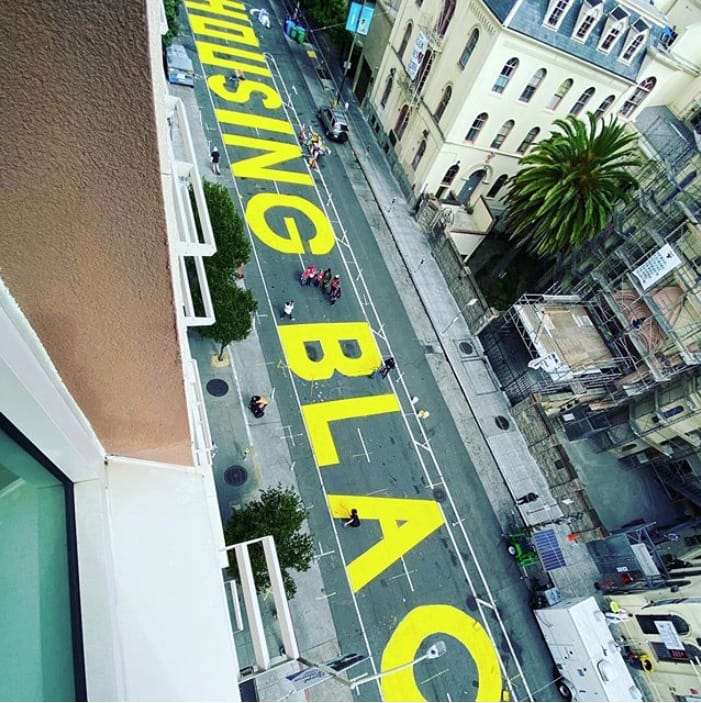
The afternoon of Aug. 10, 2020, San Francisco artist Malik Seneferu revealed a massive “Housing Black” street mural on the Tenderloin’s Golden Gate Avenue in collaboration with Code Tenderloin, St. Anthony’s, Larkin Street Youth Services, Hospitality House, District 6 Supervisor Matt Haney, organizer Geoffrea Morris and members of the Tenderloin community.
The community art process was kicked off with speeches by Code Tenderloin’s Del Seymour, Geoffrea Morris, Larkin’s Ruth Nunez, Hospitality House’s Joe Wilson, Tenderloin resident Elgin Rose, St. Anthony’s Tere Brown and Sup. Matt Haney as they discussed the importance of investing in housing for Black San Franciscans. San Francisco’s Black population makes up less than 6 percent of the city’s general population but represents close to 40 percent of people experiencing homelessness.
Del Seymour, the “Mayor of the Tenderloin” and founder of Code Tenderloin, framed the importance of the “Housing Black” message in the neighborhood: “Let’s recognize the large number of unhoused Black people navigating and residing in the Tenderloin, and let’s hurry up and house these people with dignity. This housing crisis is very rampant for Black people all throughout San Francisco and all across America. We got Black families living in tents, cars and shelters. We must not be quiet about the number of unhoused Black people that the Tenderloin community has.”
The mural is part of award-winning artist Malik Seneferu’s mural collaborations throughout the Francisco Bay Area this summer: “Black Reparations” in Double Rock, “Invest Black” in Lakeview, “Reparations Now” in Richmond and “Black Unity” in Alameda. “This communal discourse is a great way to have our voices heard,” Seneferu said. The artist has a personal history in the Tenderloin, having spent time with his family as a child experiencing homelessness in the neighborhood.
The mural spans the entire 100 block of Golden Gate Avenue at 30 feet wide and 250 feet long.
The mural unfolded in front of St. Anthony’s during their lunch service, as clients pitched in to paint the large yellow letters. Acting Executive Director Tere Brown said: “St. Anthony’s is honored to be the location for this important work of advocacy art in recognition of the unhoused Black community in the Tenderloin and in support of leaders in the Black community and housing advocates calling for long-term investment in Housing Black San Franciscans to begin immediately.”
St. Anthony’s annually serves more than 800,000 meals, feeding, clothing and offering medical services 365 days per year to guests largely from the Tenderloin, where as many as one in two adults are food insecure. Approximately 30 percent of the people they serve are Black.
“What is so historic about what we’re doing today is this is the first mural we know of that calls out ‘Housing Black’ explicitly. You cannot have a society that values Black people if you leave them out on our streets and sidewalks.”
As reported in SF Human Rights Commission’s “Reinvestment of San Francisco Police Department Budget to Support the African American/Black Community” Report, which identified access to housing as a central issue for reinvestment, African Americans have the lowest median household income in San Francisco, and the Black population is the only racial group in San Francisco to consistently decline in every census count since 1970. Their report also noted “a trend of discriminatory practices amongst landlords who do not want to rent to Section 8 voucher holders, disproportionately Black women with children. The outcome is having to find housing outside of the city.”
Joe Wilson, director of Hospitality House and co-chair of the Homeless Emergency Service Providers Association (HESPA), said: “Black people have been locked out and pushed out of San Francisco for generations. HESPA’s modest $42 million budget plan makes needed investments in housing, health, prevention and jobs. With the power of art, we imagine a better future, today.”
Supervisor Haney welcomed the mural in his district and said: “All over the country these murals are going up to give a statement about what we as a country and community value. We’re here today to say that Black lives matter, and that Housing Black lives matter.
“What is so historic about what we’re doing today is this is the first mural we know of that calls out ‘Housing Black’ explicitly. You cannot have a society that values Black people if you leave them out on our streets and sidewalks.”
Organizer Geoffrea Morris helped lead the collaboration and has also participated in the community mural projects in other San Francisco neighborhoods. She said: “Black Lives Matter movement hits home for me. My 16-year-old little brother, Leonard Bradley Jr., was killed by San Pablo Police in 2009, and since his death until now, I have vigilantly been working to improve the lives and treatment of Black San Francisco.
“George Floyd’s death and the current social uprising all over the world is a call to action for a dramatic systems change. Two out five unhoused people in this city are Black. San Francisco has a Black problem and this problem can only be fixed by truly investing into the Black community.”
Throughout the day, community members were welcomed to grab a paint brush and help with the project at 150 Golden Gate Ave. Code Tenderloin provided hygiene kits and PPE to anyone who needed it.
For more information, contact Donna Hilliard, Code Tenderloin, hello@codetenderloin.org, 510-240-2735.





